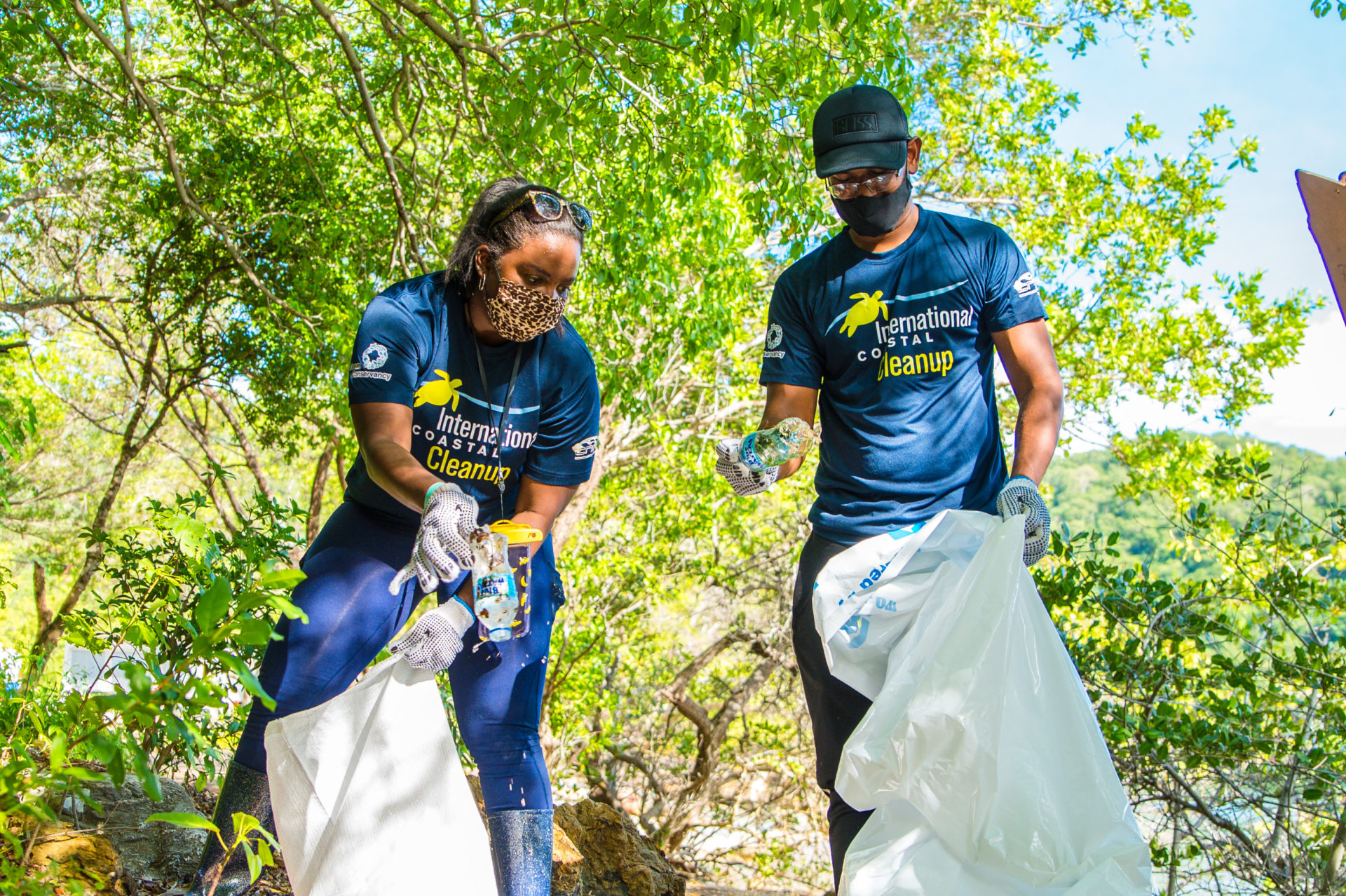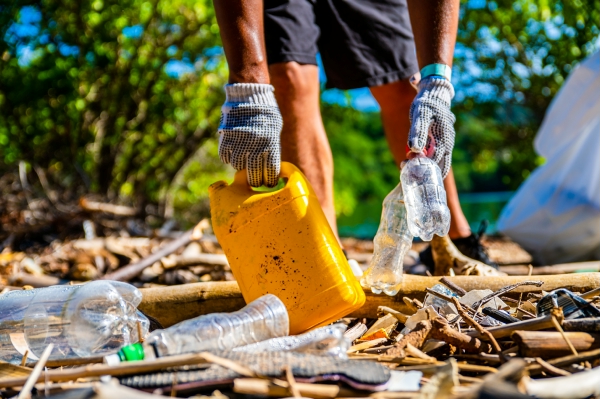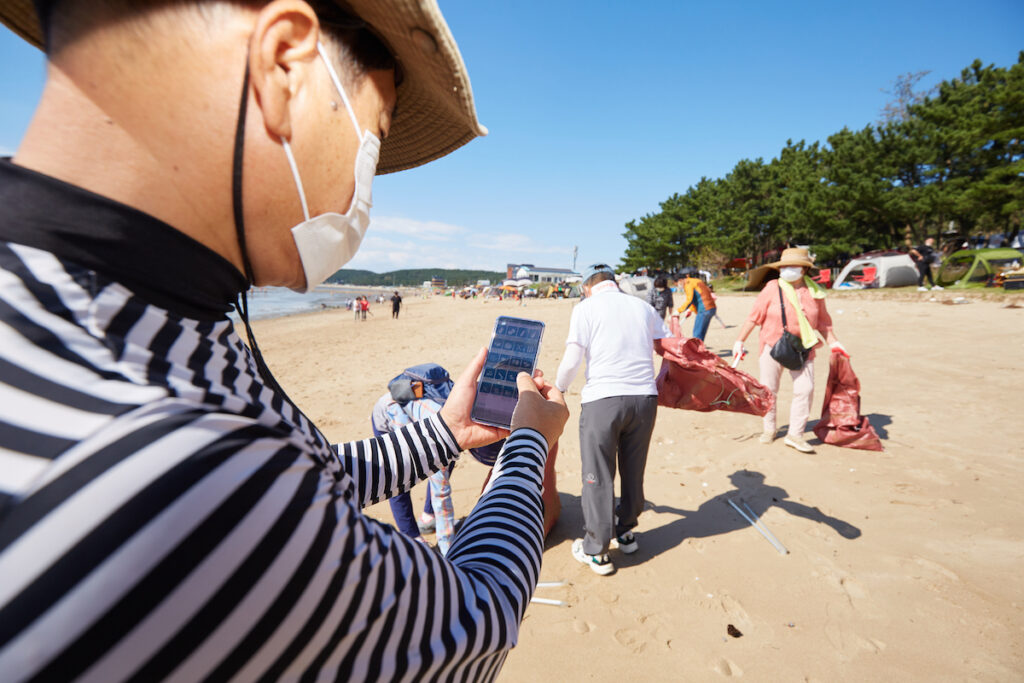
Start a Cleanup
Every year during Ocean Conservancy’s International Coastal Cleanup™, hundreds of thousands of volunteers comb lakes, rivers and beaches around the world for trash. For over three decades, more than 12 million volunteers have collected more than 220 million pounds of trash.
Join the wave. Next time you’re headed out to the beach or a nearby park, download Ocean Conservancy’s app, Clean Swell® and take along a trash bag to collect and document the debris you find.
Feeling more ambitious? Recruit friends and family to join you in a larger cleanup. Explain to them that no matter where you live—whether on the coast or hundreds of miles inland—all waterways lead to the ocean. But if we take action and work together, we can improve the ocean’s health and make trash free seas a reality.
Here’s everything you’ll need to plan your own cleanup:
Before the Cleanup
1. Pick a location
Identify beaches or waterways in your area that could be cleaned and that are safe and accessible. Contact the local parks agency that oversees the cleanup location to make sure you have the necessary permission to be there. Come up with a plan to dispose of the trash and recyclables you collect properly.
Visit the site in advance of the cleanup date to determine:
- Where to set up a check-in station
- Where to leave bags of trash and recyclables
- What areas volunteers will clean
2. Contact Your Crew
Encourage friends, family and colleagues to get involved and help organize the cleanup. Create a work event or a Facebook event so interested volunteers can RSVP and you can easily communicate with attendees. Spread the word through email, social media and e-invites. You can also print and post these event flyers in the area.
Sample Event Description:
“I strongly believe that no matter where we live, our ocean and waterways support and improve our lives. Today, plastic has been found in 62% of all seabirds and in 100% of sea turtle species. That’s why I’m teaming up with Ocean Conservancy to help keep our ocean and waterways clean and I’d like you to join me! I’m hosting a cleanup at [location] on [date and time], where we can all get together and work toward a common goal. Download Clean Swell® onto your smart phone, which will allow you to add to years of citizen science marine debris data that gives insight into other ways to tackle the enormous and growing problem of marine debris. Learn more about the International Coastal Cleanup®. Hope to see you there!”
Meetup ahead of time with other dedicated volunteers to plan the event and assign roles. In your outreach, make sure to mention Ocean Conservancy’s data collection app, Clean Swell®, for volunteers to download before the cleanup.
3. Gather Supplies
Determine what kinds of supplies you will need, such as:
- Work gloves for volunteers (or ask volunteers bring a pair of gloves with them)
- Water cooler with enough water to keep volunteers properly hydrated, especially in warm temperatures (or remind volunteers to bring their own)
- First-aid kit for minor cuts and scrapes
- Depending on weather, sunscreen and bug spray may be needed
- Trash bags (or request your volunteers bring reusable containers, like buckets)
- Sign-in sheet to record the number of participants and enable you to contact them later with thanks and photos
- Pens or pencils
- Information on how to download Clean Swell® or Cleanup data cards. Note that both the Clean Swell® app and the data cards are available in multiple languages. Contact [email protected] for more information.
- Hand sanitizer or wipes are nice to have available for volunteers after the cleanup
- Optional: If you have a fish or a luggage scale (a scale with a hook) at home, you can use it to weigh the trash you collect.
4. Keep These Safety Tips in Mind
Review what to do in case of a health emergency (heat exhaustion or heatstroke, broken bone, etc.) and find out whether any of your volunteers have medical training or know basic first aid.
When visiting the site, look for natural and man-made safety hazards, such as rocky areas, highly variable tides, poisonous plants, high-speed roads, power lines, etc. If necessary, inform your volunteers that they may need to dress accordingly, such as wearing long pants or closed-toed shoes.
Plan ahead for handling sharp items, such as syringes or pieces of broken glass. We recommend disposing of these items in a wide-mouth container with a tight screw lid, such as an empty liquid laundry detergent bottle that you have clearly labeled.
Find out how to contact your local Fish and Wildlife Service office in case you encounter any dead, entangled or injured wildlife. You can report these finds on your data form or on the comments section in the Clean Swell® app, but be sure to leave any wildlife handling to the experts.
5. Plan Ahead to Reduce Waste at Your Event
Food
Providing a meal at your cleanup can be tricky when you’re trying to reduce waste! Use these tips to cut down on packaging, single-use plastics and food waste.
- Provide healthy snacks, such as fruit, that don’t require packaging!
- Serve easy to eat food. Finger food—sandwiches and veggies/chips & dip—can be eaten without cutlery.
- Ask volunteers to bring lunch with them, or make it a potluck!
- If you host events regularly, it may be best to purchase cheap, but reusable, plates and silverware that you wash in between events.
- If ordering from a restaurant for a meal, make sure to speak with them beforehand about your choice to minimize waste.
- Local, small-businesses and restaurants are recommended.
- Donate any leftover food to a local soup kitchen (locate one beforehand and communicate about what they can accept!) or suggest that volunteers bring food home with them to eat later.
Water
Volunteers must have water at cleanups, but it doesn’t have to be from a disposable bottle! Avoid single-use plastics with these tactics.
- Provide a container of water at the event and encourage volunteers to bring reusable water bottles. Make sure to pack reusable or compostable cups as well for those without.
- Purchase, borrow, or rent reusable water solutions to avoid using single-use plastic water bottles.
Materials
Learn how to find reusable, sustainable, material solutions.
- Rather than single-use latex gloves, purchase reusable gardening gloves to use over and over for cleanups! Wash them in a regular laundry machine in between cleanups (let them air dry if they have rubber on them). Or you can always ask volunteers to bring their own reusable gardening gloves.
- Use Clean Swell®! Data cards produce unnecessary waste and mailing them back to Ocean Conservancy costs time and money. If you are able to, use Clean Swell® to save on resources. If you use the paper data form, scan and email it to [email protected] after your event to avoid postage.
Transportation
Reduce the impact from transportation to the event with recommendations to volunteers.
- Suggest that volunteers walk, bike, use public transport, or carpool to the event.
Deposit Bins
Make sure to label bins with explanations of what items can go where. Tape signs to bins for “Compost,” “Recycling,” and “Landfill”. You can sort the debris you collect and the waste generated during the event. This is a great educational moment for volunteers!
- Recycle: Be aware of what items your local recycling receptacle accepts and be sure to sort any items collected or used during the event to be recycled. This may include plastic, metal, or glass items.
- Compost: Perhaps a volunteer has a compost bin at home or your municipality has a compost system in place. Collect organic materials such as food scraps and paper in this bin to be used in the future (if organics are left in landfills, it can interact with waste and generate immediate combustion of methane, a greenhouse gas over 100x more damaging than carbon dioxide).
- Liquids: Sort out liquids so they don’t get sent to landfills (Find a disposal site near you)
- Potentially hazardous materials: Check with your local municipality to see what can be done with batteries, electronics, tires and even paint.
- Landfill: Any items that are not recycled, composted or disposed of in another way should be sent to the landfill.

During the Cleanup
1. Set up
Arrive early to set up, post signs and label your trash drop-off site. At your check-in station, ensure you have pens, pencils and sign-in sheets ready for your volunteers.
2. What to Tell Volunteers
Emphasize the importance of data collection. Make sure everyone has the Clean Swell® app downloaded so they can keep track of the items they are collecting. You can find a simple How-To-Use Clean Swell® poster here.
The valuable data they collect is used to create a snapshot of the global ocean trash problem and influence long-term solutions. Provide volunteers with a group name to be entered on each user’s collection screen—this makes it easy to look up your group totals later. With both data cards and Clean Swell® (available in multiple languages), make data collection easier by suggesting that volunteers work in small teams that can share one data card. Designating a data recorder for each group is recommended. It is easier to collect data as items are picked up, rather than sorting and tallying everything after you clean.
Instruct volunteers on what to do if they encounter any hazardous items, such as sharp objects or dead, entangled or injured animals. Remind them of any local safety hazards, such as power lines or poison ivy.
Establish a point person to stay at the check-in station in case of health emergencies or any late arrivals.
Tell volunteers what to do with the filled bags of trash and set a meeting time for the end of the cleanup so that everyone returns at the same time. Kids should always have adult supervision.
3. Document the Cleanup
Take before and after photos of the cleanup site as well as shots of your volunteers in action and a final group picture with all of the trash collected. Clean Swell® has a photo icon in the top right-hand corner that allows volunteers to take photos during their cleanup which are automatically submitted with their data!
If you have a scale with a hook, use it to weigh the trash bags. If you don’t have a scale, you can use a standard conversion of 15 pounds per trash bag to estimate the overall weight of your collected trash.
As the volunteers finish, remind them to review the information they entered into Clean Swell®, such as number of participants and then make sure they submit. Collect all completed data cards and email them to Ocean Conservancy at [email protected].
Ensure all trash is left in the designated drop-off location and that no materials are left behind as you leave the cleanup location.

After the Cleanup
1. Share Your Results
After your volunteers submit their data on Clean Swell®. Encourage them to share their cleanup on Instagram, Facebook, and Twitter.
If your volunteers used data cards, enter them into Ocean Conservancy’s database! Create an account, select your location on the map and enter your information. Double check to ensure the date, number of participants, weight and distance are correct and with the correct units.
If you have any questions, or would like to share photos or highlights, feel free to reach out to Ocean Conservancy:
Email: [email protected]
Survey your cleanup team post-event. Encourage everyone to share experiences, stories and pictures about what they saw. This might encourage others to attend future events—and now is the time to start planning. Let them know about your next cleanup; get volunteers onboard while their enthusiasm is high!
2. Say Thanks
Send out an email saying, “Look what we did!” Include how many friends, family and community members joined in and the weight of trash were collected. Celebrate your accomplishment as a cleanup organizers and ocean advocate.
Thank you!